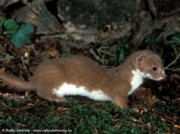

Genus:
Mustela
Species: nivalis

Deep in the woods of the Northeast Asian deciduous forest roams the least weasel. Its long slender body and sharp nails help this mammal hunt day and night. The least weasel is the smallest carnivore in the world. The least weasel's habitat consists of living in stone walls, hedges, farmland, and the woods. Least weasels avoid deep forests, sandy deserts, and open spaces. Male and female least weasels both have their own territory. Females may overlap with another female, but a male's territory is all his, he may even fight for it. The male's territory may consist of 40 acres.
The least weasel is mostly found in the Northeast Asian deciduous forest, which covers Korea, Eastern Asia, Japan, China, and Russia. Least weasels can range in this area from 30 degrees to 47 degrees North latitude and 110 degrees east Fahrenheit to 145 degrees east Fahrenheit in longitude. The Northeast Asian deciduous forest has warm summers and cold winters. It is home to many mammals and birds but is currently threatened because of loggers chopping down trees.
The least weasel's coat is a dirty brown and dirty white color most of the year, but in the winter the fur turns to pure brown and pure white to blend in with the snow. The coat does not grow longer than 0.6 inches. It has a slender body, which are 4 to 10 inches long. A male's weight ranges from 1.5 to 8.75 pounds. A female's weight ranges from 0.8 to 4.3 pounds. The least weasel's head is long and an oval shape, like a ferret. Their eyes are usually black and their ears are short and stubby even though they have very good hearing. Least weasels have very good sense of smell with their long nose. Their paws have 5 toes with sharp claws used as weapons in hunting.
The least weasel becomes sexually mature at 3-4 months. Their mating seasons are spring and summer with a gestation period lasting from 35-37 days. The least weasel has 3-10 babies, weighing 0.04 to 0.06 ounces, and are wrinkled, pink and naked. They have no abilities. The mother raises the young by herself while the father leaves right after mating. The baby least weasels are weaned at four to five weeks and the mother hunts for them until they are 4 weeks old. At that time the training of adulthood begin s. The least weasels are fully independent at 12 weeks old, at which time they leave their family. The least weasel's interval is its den and it is mostly solitary. These mammals live up to 2 years in the wild and up to 10 years in captivity. Least weasels are active day and night.
The least weasel's diet consists of mice, rats, moles, small birds, bird's eggs, rabbits, and poultry. The least weasel's claws and sharp teeth help this animal to catch their prey. The least weasel is the smallest carnivore in the world. It can kill prey up to 5 times its own size. The least weasel's predators are large hawks and owls. This animal benefits our environment because it kills rodents to keep the population low. One way a least weasel helps itself survive in its environment is its coat and how it changes to blend in with the snow. The least weasel is not endangered but more of them are dying because the loggers are pushing them out of their home. This animal has basically no predators but because of its short life span its not overpopulated.
Most interesting about the least weasel is that it is the smallest carnivore. It is amazing that something so small can kill something so much bigger than it can. Its habitat and biome, the Northeast Asian deciduous forest, is endangered. The least weasels are fleeing from their homes and drowning in oceans trying to get away from the loggers. If we try to preserve the Northeast Asian deciduous forest we can help the least weasel from being extinct.
by Phoebe H. 2003
Bibliography:
Photo credit: Rollin
Verlinde
http://www.natuurbeleving.be/zoogdieren/Wezel_Mustela-nivalis.html
"Least Weasel" Wildlife Explorer. International Masters Publishers AB, 1998, USA.
Long, A. Charles, Weasel World Book #21 2000 by World Book Inc.
"BioKIDS: Mustela
Nivalis/Information",
http://www.biokids.umich.edu/critters/information/Mustela_nivalis
(12/02)
"Least Weasel",
http://www.ladywildlife.com/animal/leastweasel.html
(12/02)
Newell, Toni Lynn.
"Mustela nivalis (Least Weasel): Narrative",
http://animaldiversity.ummz.umich.edu/accounts/mustela/
m._nivalis$narrative.html
(12/02)